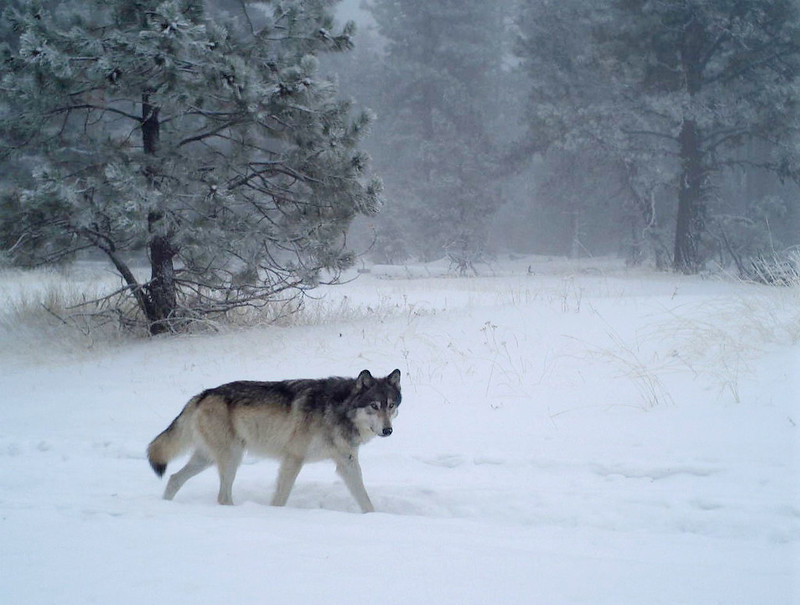State biologists say the gray wolf population in the eastern third of Oregon may have reached its ecological limit, and wolf populations could spread significantly to the west and south.
The comments were made at a meeting of the state Fish and Wildlife Commission five wolves released Trapped from Oregon as part of a historic reintroduction program.
There are nearly 25 packs of about 200 gray wolves in Oregon, Oregon Fish and Wildlife wolf coordinator Roblyn Brown told ranchers and conservationists last week. She said the wolf population has leveled off in recent years because most wolves live in northeastern Oregon, where wolf populations have become increasingly crowded. Wolves first resettled in Oregon in 2009, 50 years after they were wiped out by hunting and harassment.
Wildlife agencies counted 178 wolves in the state in 2022, up from 175 in 2021 and 173 in 2020, though officials said that number was an underestimate. Their numbers have stabilized in recent years after a decade of surge. Wolves have become established in central and southwestern Oregon, with wolves in Jackson County notorious for preying on cattle.
“In the next few years, we’re going to start seeing more wolves in other areas of Oregon,” Brown said.
But conservationists worry the agency More wolves are being killed As wolves increasingly prey on livestock.
Illegal hunting also continues to plague wolf populations.Provided by U.S. Fish and Wildlife Service $26,500 Award Get information that led to convictions in two separate wolf killings in November, one of which occurred in Jackson County. Wolf hunting is illegal in Oregon, and Jackson County’s wolves, like all other wolves in central and western Oregon, are protected under the federal Endangered Species Act.
Still, at the Fish and Wildlife Commission meeting, Brown said the continued growth of the wolf population is a major accomplishment.
She said Oregon’s nearly 90 percent annual adult wolf survival rate is higher than other western states like Idaho and Montana that authorize wolf hunting. All. Both states have significantly more wolves than Oregon.
Derek Broman, the agency’s game program manager, said some of the environmental challenges expected to plague Oregon’s wolves aren’t problems after all. Conservationists have long been concerned that a lack of genetic diversity among different wolf populations could make wolves more susceptible to canine disease and environmental damage.
“Some of these conservation threats are no longer what they were five years ago,” Broman said.
Trust among ranchers and wildlife managers is growing as the process for investigating livestock kills becomes more efficient, said John Williams of the Oregon Cattlemen’s Association, which remains a small group of ranches losing cattle, sheep and goats The owner’s concerns. He said the agency is also streamlining the process for authorizing the killing of predatory wolves.
“We are encouraged by this direction,” he told the committee.
The Oregon Legislature also issued this year $ 1,000,000 According to Capital Press, ranchers are being compensated for livestock losses more than in any year since lawmakers created the state program in 2011.
The plan remains the same
After hearing from wildlife officials, ranchers, hunters and conservationists, the commission decided not to reform the state’s wolf management plan, a painstakingly crafted set of rules and regulations that have been criticized for The state-sanctioned wolf hunt was divided over animal protections and took four years to finalize. Attacks on livestock.
Instances of both are increasing. Investigators confirmed that wolves killed 76 private livestock last year, compared with 16 in 2019.
The agency has authorized the killing of 16 wolves so far this year, according to agency data compiled by the Western Environmental Law Center, an environmental advocacy group. That’s an increase from an average of less than four wolves per year from 2019 to 2022. This summer, the agency killed six gray wolves in six weeks, angering conservationists.
Christy Kamal, associate director of the Western Environmental Law Center, said wildlife agencies rely too much on legal wolf killings to protect livestock.
She said they were now vigorously choosing lethal actions.
Predating livestock is a learned skill for some wolves, but two-thirds of Oregon’s wolf populations do not possess this ability, state wolf biologist Holly Turse-Lance said at the meeting.
According to the agency, only eight livestock producers have experienced half of all known livestock forecasts. Data can help wolf managers thoughtfully reduce conflicts between wolves and communities, she said.
Fish and Wildlife officials said they will only issue wolves if ranchers are able to record at least two incidents of livestock depredation in a nine-month period and other methods, such as building fences, recruiting livestock dogs or guarding cattle, have failed to stop the wolves. Only then would he be authorized to kill the wolf. .
Additionally, wolf execution is prohibited in most of the state because wolves outside of eastern Oregon are protected under the federal Endangered Species Act.
Tours-Lance said federal law has hampered the agency’s efforts to protect livestock from rogue wolves in southern Oregon, which killed livestock more than 60 times from 2016 to 2022, according to agency data.
Experiments with non-lethal deterrents and new technologies have not worked, and ranch owners have spent an unsustainable amount of time trying to prevent conflict, she said.
Get the morning’s top stories delivered to your inbox
#Oregon #wolves #expected #spread #west #south #Oregon #Capital #Chronicle
Image Source : oregoncapitalchronicle.com
